U.S.S.R. 1917-1991
Moscow Rules was the term coined by intelligence officers in the early 1960's. This followed the arrest of the joint SIS/CIA agent, Col Oleg Penkovsky, due to poor spy craft. Moscow Rules were a set of clandestine procedures developed specifically for operations in the Soviet capital. They remain in place today.
Counter-intelligence was the preserve of the KGB's Second Chief Directorate (SCD), which had its headquarters in the Lubyanka in Dzerzhinsky Square (see below). External intelligence gathering was the preserve of the First Chief Directorate (FCD) headquartered in Yasenovo in the outskirts of the city. Other KGB directorates were concerned with communications, border security, VIP protection and such like. The KGB maintained about 17 separate offices and facilities in Moscow.
Within the SCD the 7th Department ran the KGB's surveillance operations. They were feared by their Western opponents both for their professionalism and the resources available to them. That said, those who were familiar with staffing levels in the FBI's counterintelligence office in New York during the Cold War say the numbers there exceeded those available to their Soviet counterparts in Moscow. (Today the Bureau 'admits' to having about 1,500 in its Field Office in New York.)
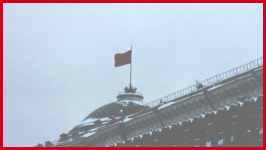 The Red Flag flies over the Kremlin…but for how long?
The Red Flag flies over the Kremlin…but for how long?
Photo © Paddy Hayes.
The flag is on the roof of the building of the Council of Ministers of the USSR, formerly the Committee of People's Commissars.
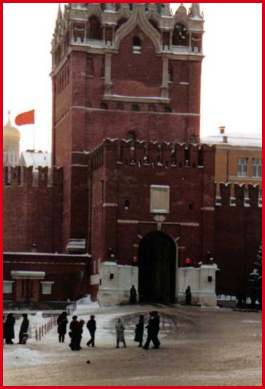 Saviour Gate in the Kremlin opening on to Red Square.
Saviour Gate in the Kremlin opening on to Red Square.
Photo © Paddy Hayes.
The well-guarded entrance led directly to the Presidium of the Supreme Soviet of the USSR, the flag flies from its roof. Within days of this picture being taken 400,000 demonstrators had crowded into the square to hear Boris Yeltsin demand 'independence' for Russia. In less than a year he had achieved it, albeit at a price; the end of the Soviet Union.
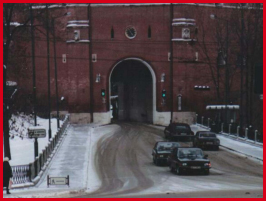 Zil limousines of Politburo members, with their KGB escort cars in tow, enter and leave the Kremlin by the Pinewood Tower; this led directly to the Grand Kremlin Palace.
Zil limousines of Politburo members, with their KGB escort cars in tow, enter and leave the Kremlin by the Pinewood Tower; this led directly to the Grand Kremlin Palace.
Photo © Paddy Hayes.
As this photograph was being taken desperate efforts were being made to prop up the failing entity. President Gorbachev was in continuous session with the recalcitrant presidents of the 'Republic's' who weren't only demanding autonomy but were taking it. Yeltsin was plotting one outcome, the Grey Cardinals (senior KGB and Politburo members) and Black Colonels (revisionist army officers) another. The world was watching.
Already the satellites of East Germany, Poland, Hungary, Bulgaria and Czechoslovakia had left the Soviet orbit. Demonstrations had broken out in the Baltic Republics and had been put down with force. Could the unthinkable happen and the Union itself collapse? Right up to the end few believed it possible.
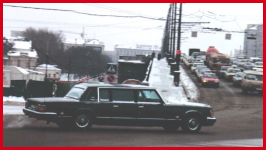 As traffic is halted, a Zil, its windows curtained, accelerates towards the Chaika lane reserved for the elite ‘nomenklatura’.
As traffic is halted, a Zil, its windows curtained, accelerates towards the Chaika lane reserved for the elite ‘nomenklatura’.
Photo © Paddy Hayes.
Chaika lanes (called after the predecessor to the Zil limousines) ran down the centre of all major highways and main streets in major cities. In theory they were designed for emergency vehicles, in practice they were a perk for ministers and other high-ups in the Communist system.
In Putin's Russia use of the Chaika lane is open to all. All, that is, who can afford the $25,000 a year rental. But, for their $25K not only do users get to use the lanes they also get a permission to have a siren and flashing blue light fitted to their own car and an escort. Plus c'as change.
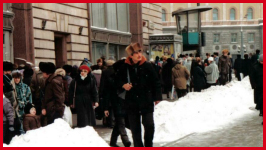 While in the streets the queues lengthen, a police officer in his tower looks on.
While in the streets the queues lengthen, a police officer in his tower looks on.
Photo © Paddy Hayes.
The nomenklatura lived a privileged existence. Not for them the hardships of daily existence of the Soviet masses. No one left home without their 'just-in-case' bag (just in case they came across something they could buy). The prospect of starvation was real and immediate.
Glasnost (openness) wasn't working.
Perestroika (reconstruction) was a sour joke.
Gorbachev, a hero in the West, was a joke in his own land.
The monthly meat ration (with coupons) was 500 grams of cooked sausage and 300 grams of smoked sausage. Real meat (and dairy products) was available in the semi legitimate semi privatised farmers markets. But meat at 150 Roubles for a portion was prohibitive in a country where a third of its citizens lived on less than 100 Roubles a month. And so people hoarded and queued, bartered and hoarded.
The situation outside Moscow was worse (as it is today though in a different way). Every day commuter trains, known as kolbasnye elektrichki (sausage trains) descended on the capital. They were jammed with people desperately seeking food, food that was proving impossible to find. It was not unusual to see literally nothing on sale in a major store such as GUM, with the exception of Soviet propaganda. But the days of sullen resignation were over. Too late Gorbachev took away some of the privileges of the nomenklatura. It wasn't enough. If Glasnost did nothing else it let the genie of rebellion truly out of the bottle.
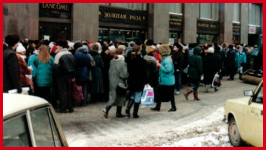 Foreign currency shops became the only outlet.
Foreign currency shops became the only outlet.
Photo © Paddy Hayes.
For those, relatively, few who had access to foreign currency priceless Western consumer goods could be purchased. Again queues were long, opening hours short. As can be seen outside this cosmetic store.
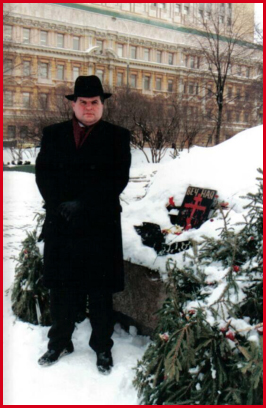 Paddy Hayes pictured at the statue of the 'Great Chekist' Feliks Dzerzhinsky in Dzerzhinsky Square outside the Lubyanka in 1991.
Paddy Hayes pictured at the statue of the 'Great Chekist' Feliks Dzerzhinsky in Dzerzhinsky Square outside the Lubyanka in 1991.
Photo © Paddy Hayes.
The Lubyanka was the headquarters of the KGB's Second Chief Directorate, the one responsible for internal security and counterespionage. Running agents in the teeth of the SCD's surveillance capability posed real difficulties. But the difficulties had to be overcome. As a general rule agents need to have at least one personal meeting a year, two is preferable. Meetings (treffs in the jargon) are essential to keep the agents motivated, to assure them that their work is valued, that their security is paramount to the organisation running them. Meetings too are essential to gauge the state of the agents' morale, to determine their likely forward shelf life and also to detect any alterations in behaviour that might indicate they have been turned.
Arranging a treff in a country away from the eyes of the agents' host counterintelligence service is considered the ideal. The KGB favoured Vienna for this. It was a city popular with Western tourists so their agents could visit it without drawing suspicion on themselves. The operational environment too was favourable. Austria was neutral and the Soviet intelligence infrastructure in the city was comprehensive.
The CIA and other Western intelligence services had no 'Vienna' equivalent to draw on. Overseas travel for Soviet citizens was carefully controlled. Passports were issued on a trip-by-trip basis and only after preparation of a file by the KGB on the trip and its purpose. Some agents were able to travel abroad (Penkovsky was one) most could not so arrangements had to be put in place to meet with them in Moscow or other Soviet city of residence.
The American (CIA) and the British (SIS) tended to use different methods. The CIA favoured the use of embassy-based officers under what is called 'light' or 'official' cover. This was because of the protection afforded by diplomatic immunity. The agency relied on a combination of tradecraft and technology to outwit the 'watchers', as it still does today. It does however make use of Non Official Cover (NOC) officers
Part of the technology relied upon by the CIA are highly sophisticated disguises. Some of Hollywood most sophisticated make-up and special effects experts work in close co-operation with the Agency's specialists in disguise, false documentation and clandestine photography. The details are secret but work on the following general principles.
1. Disguises that alter age, gender, state-of-health including creating the appearance of physical deformities.
2. Disguises that alter ethnicity. (Especially useful in non-Caucasian countries).
3. Disguises that can be used to alter a person's appearance so that they appear to be someone other than themselves. This is used to good effect in situations of intensive surveillance where the followers can be fooled into thinking they have their subject under surveillance when in fact he/she has been substituted for by a doppelganger. This can be done by the subject entering an apartment and his 'doppelganger' leaving it, the subject slipping out later, perhaps disguised as the 'real doppelganger'. Alternatively it can be affected during surveillance when the subject turns a corner (or otherwise enters a 'blind zone') for a brief period. To pull this off requires superb timing and not a deal of chutzpah.
SIS, while it uses embassy based officers as agent handlers often relies on what it calls Visiting Case Officers (VCO's) operating under 'deep' cover.
A Visiting Case Officer is based outside the 'operational territory' and only visits to service the agent before leaving again. Visits will usually involve a face-to-face meeting, but might include loading or emptying a 'dead drop'. Though for the latter embassy personnel are often used, the spouses (wives) of officers being specially trained in the art. The VCO may use an assumed identity or may have a cover occupation that he/she 'lives' throughout the year. The longer and more they have lived it the more 'natural' it becomes and thus less likely to arouse suspicion and more easily defended if it does. SIS calls such deep cover 'Natural Cover'. The Service expends a deal of energy on improving its capability in this area. Today in addition to its VCO's, SIS also uses an increasing number of Resident Case Officers (RCO's) who live for extended periods in their operational territory. This holds true for Arab countries in particular. VCO's and RCO's, without the physical and diplomatic safety that is afforded embassy-based officers, run a real risk of arrest, assassination and torture.
VCO's rarely come into public view. Valerie Plame is the CIA's best known, One SIS VCO was John Wyman (possibly not his true name). He was the VCO for an agent SIS was running in the Irish Garda during the early 1970's. Irish counterintelligence operatives uncovered the agent and arrested Wyman while he was conducting a treff in a Dublin city centre hotel. He was armed but did not offer any resistance.
Tough business being a VCO.
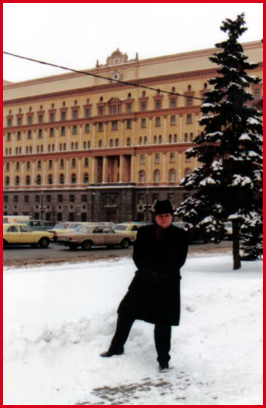 'And behind him the plotters plot.' Paddy Hayes also pictured, this time in front of the Lubyanka six months almost to the day before the August 1991 coup.
'And behind him the plotters plot.' Paddy Hayes also pictured, this time in front of the Lubyanka six months almost to the day before the August 1991 coup.
Photo © Paddy Hayes.
In the foreground are the Volga cars of some of the SCD staff based here.
Gorbachev had by now 'lost' the KGB. Led by its chairman, Vladimir Kryuchkov the organisation was preparing for a coup. The previous September units of the Ryazan elite paratroop regiment had staged what amounted to a rehearsal in the city. The same troops would be to the fore again in the real coup a few months later.
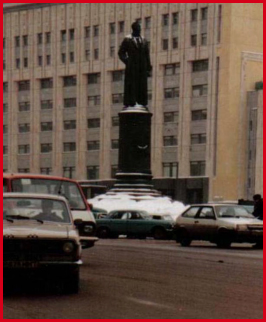 'Iron Feliks' himself.
'Iron Feliks' himself.
Photo © Paddy Hayes.
Feliks Dzerzhinsky the Polish born founder of the CHEKA (forerunner of the KGB) and inspiration for all who follow including today's FSB/SVB.
An angry mob hauled down the statue on the final day of the abortive coup in August 1991. They were however persuaded not to storm the Lubyanka itself, unlike the citizens of East Germany who ransacked Stasi offices throughout the DDR.
Their actions revealed to the world the extraordinary surveillance history of the regime. But everything the Stasi did was modelled on the practices of their Soviet overlords. How different the development of the modern Russian state might have been if the populace there too had had their own 'Stasi' day.
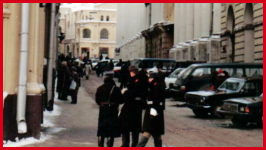 Soviet era militia, they were rarely seen in anything but numbers.
Soviet era militia, they were rarely seen in anything but numbers.
Photo © Paddy Hayes.
For people who followed Daphne Park they were the visible reminder of the invisible presence of the 7th Department's goons.
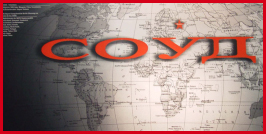 'System for the united registration of data about the opposition'
'System for the united registration of data about the opposition'
Photo BstU museum
A KGB organised database of suspected members of Western intelligence services. It also listed those suspected of carrying out 'political and ideological subversion' or 'subversive activities against the states of the Socialist community'. Participants/contributors included the security services of Bulgaria, DDR, Cuba, Mongolia, Poland, Soviet Union, Czechoslovakia and Vietnam. The database was maintained by the KGB and located in the Lubyanka. It contained over 180,000 names.
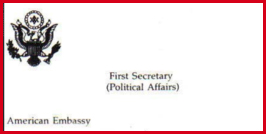 Even spies have cards.
Even spies have cards.
Sometime in 1991 a group of US diplomats (and spies) were shooting the breeze in the Moscow apartment belonging to one of them. 'Talking to the Walls' would have been the expression they used because they were well aware that their apartments were comprehensively bugged. They were debating the likely outcome of a soon-to-be-taken vote in the Duma. Without warning the telephone rang. A Russian voice on the other end said.
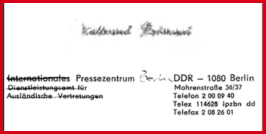 "This is the way the vote will go…" And proceeded to tell them.
"This is the way the vote will go…" And proceeded to tell them.
The assorted diplomats and spies laughed, the listeners were well informed. More to the point they realised that the end of the Soviet Union must be near. The phone call was a pointless (and extraordinary) breach of discipline by the 'listeners', an act that could never have been contemplated a few years previously. It was from minor pieces of information like that as much as major technical ones that conclusions can sometimes be drawn.
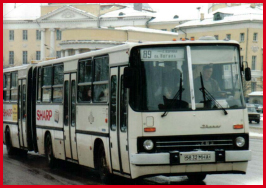 A Moscow city 'bendy-bus', still seen today.
A Moscow city 'bendy-bus', still seen today.
Photo © Paddy Hayes.
The advertisement on the side panel tells it all. Glasnost is underway, even a few years previously such an ad would have been unthinkable.
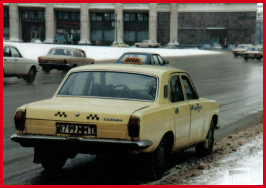 Moscow's once ubiquitous 'yellow taxis'.
Moscow's once ubiquitous 'yellow taxis'.
Photo © Paddy Hayes.
Not seen much now if at all. Current regulations permit any vehicle to carry passengers for reward at a price to be negotiated between driver and passenger. In practice two fares apply, the rate for Muscovites and the rate for visitors, and 'never the twain shall meet'. Most of the traffic in this picture appears to be is official vehicles (Volga saloons, the car-of-choice for KGB and middle ranking bureaucrats). Today Moscow's traffic rivals any cities in terms of congestion.
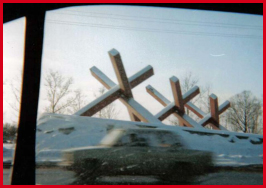 This monument, a huge tank obstacle, marks the furthest point of Hitler's advance on Moscow.
This monument, a huge tank obstacle, marks the furthest point of Hitler's advance on Moscow.
Photo courtesy of Joe McCarthy.
It is situated on Leningradsky prospekkt, the highway that leads from Sheremetjevo II Airport to Moscow city centre. It was said that the Germans could see the flashes from the anti-aircraft guns on the walls of the Kremlin from here.










